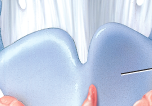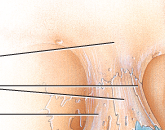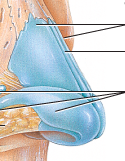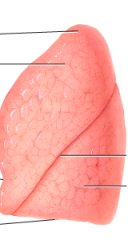![]()
![]()
![]()
Use LEFT and RIGHT arrow keys to navigate between flashcards;
Use UP and DOWN arrow keys to flip the card;
H to show hint;
A reads text to speech;
165 Cards in this Set
- Front
- Back
|
What is ventilation? |
The act of breathing (not the same as respiration). |
|
|
What is respiration? |
The exchange of gases |
|
|
What is the respiratory system responsible for? |
a) Ventilation b) Exchange of gases (respiration) c) Regulating blood pH d) producing speech |
|
|
What is the respiratory tract? |
The path of air from the nose to the lungs. |
|
|
What are the two sections of the respiratory tract? |
a) Upper respiratory tract b) Lower respiratory tract |
|
|
What constitutes the upper respiratory tract? |
The beginning of the airway @ nostrils to the pharynx. |
|
|
What constitutes the lower respiratory tract? |
From the top of the trachea to the diaphragm |
|
|
What are the three parts of the pharynx? |
1) Nasopharynx 2) Oropharynx 3) Laryngopharynx |
|
|
The top part of your throat where nasal cavity drains. Consists of the hard and soft palate. |
What is the nasopharynx? |
|
|
Bony plate that separates your mouth from your nose. |
What is the hard palate? |
|
|
Moves backward when you swallow so that the nasopharynx is blocked. |
What is the soft palate? |
|

|
Soft palate |
|
|
Middle part of you throat, often called the back of the throat. Extends from the uvula to the level of the hyoid bone. |
What is the oropharynx? |
|
|
The epiglottis is located in the ________________ of the pharynx. |
The oropharynx portion |
|

|
Nasal conchae (superior, middle, and inferior) |
|
|
Anteriorly, the nasal cavity merges with the external nose, and posteriorly it communicates with the pharynx through two openings called the__________________________. |
Internal nares or choanae
|
|

|
Internal nares (& ends of choanae) |
|

|
Hyoid bone |
|
|
Extend out of each lateral wall of the nasal
cavity. Almost reaching the nasal septum, subdivide each side of the nasal cavity into a series of groovelike passageways. |
What are the nasal conchae?
|
|
|
What are the groovelike passageways created by the conchae called? |
The superior, middle, and inferior meatuses
|
|

|
Thyroid cartilage (Adam's Apple) |
|

|
Cricoid cartilage (posterior side of larynx) |
|

|
Trachea cartilage |
|

|
Thyroid gland and parathyroid glands |
|
|
Lower part of the throat adjacent to the larynx. |
What is the laryngopharynx? |
|
|
At apex of larynx and is commonly known as the Adam's apple. |
What is the thyroid cartilage? |
|
|
The voice box (triangular in shape). |
What is the larynx? |
|
|
A flap of tissue that covers your glottis and blocks food from getting into the larynx. |
What is the epiglottis? |
|
|
Is superior to the larynx, is an opening through which air passes. |
What is the glottis? |
|
|
Is located anterior to the esophagus and extends from the larynx to the superior border of the fifth thoracic vertebra (T5), where it divides into right and left primary bronchi.
|
What is the trachea? |
|
|
Are triangular pieces of mostly hyaline cartilage located at the posterior, superior border of the cricoid cartilage.
|
What are arytenoid cartilages?
|
|
|
Is a ring of hyaline cartilage that forms the
inferior wall of the larynx. |
What is the cricoid cartilage?
|
|
|
What are the layers of the tracheal wall, from deep to superficial?
|
(1) mucosa, (2) submucosa, (3) hyaline cartilage, and (4) adventitia (composed of areolar
connective tissue). |
|
|
The mucous membrane of the is__________ one of the most sensitive areas of the entire larynx and trachea for triggering a cough reflex.
|
Carina
|
|
|
What is the branching of the bronchiole tree? |
Trachea--> primary bronchi--> secondary bronchi--> tertiary bronchi--> bronchioles--> terminal bronchioles. |
|
|
Transports the blood containing the gas. |
What is the cardiovascular system? |
|
|
What are the two functional parts of the respiratory system? |
a) conducting zone b) respiratory zone |
|
|
Series of interconnecting cavities and tubes both outside and within the lungs. These function to filter, warm, and moisten air and conduct it into the lungs. |
What is the conducting zone? |
|
|
Tubes and tissues within lungs where gas exchange occurs. Functionally, is the main sites for gas exchange between the air and blood. |
What is the respiratory zone? |
|
|
Why are the conchae and meatuses important? |
Increase the surface area in the internal nose and prevents dehydration by trapping H20 during exhalation. |
|
|
What are the 3 functions of the external nose? |
1) warm, moisten, filter incoming air 2) detecting olfactory stimuli 3) modifying speech vibrations |
|
|
What are the structures of the external nose? |
a) Boney framework b) Cartilaginous framework |
|
|
The structures of the boney arch/framework? |
Frontal bone, nasal bone, and maxillae |
|

|
The boney arch: frontal bone, nasal bone, and maxillae. |
|

|
The cartilaginous framework: lateral nasal cartilages, septal cartilage, alar cartilage. |
|
|
What happens to inhaled air as it whirls around the conchae and meatuses? |
It is warmed by blood capillaries. |
|
|
Mucus secreted by_________________, moisten the air and trap dust particles. |
Goblet cells |
|
|
Move the mucus and trapped dust particles toward the pharynx, @ which point they can be swallowed. |
What are the cilia? |
|
|
Olfactory receptors, supporting cells, and basal cells in the respiratory region. |
What are olfactory epithelium? |
|
|
The most inferior cartilage of larynx. |
What is the circuit cartilage? |
|
|
What role do skeletal muscles play in regards to the pharynx? |
When relaxed they help keep it open. When they contract they help with deglutition. |
|
|
How many openings are in the nasopharynx? |
5: - Two internal hares - Two openings that lead to the auditory tubes - One opening into the oropharynx |
|
|
Which section of the pharynx can you find the pharyngeal or adnoid tonsils? |
They are located in the nasopharynx. |
|
|
The nasopharynx is lined with ________________ and _________________. |
Pseudo stratified ciliated columnar epithelium, cilia. |
|
|
What is the interaction between the nasopharynx and the auditory tubes? |
Exchanges small amounts of air to equalize air pressure between the pharynx and middle ear. |
|
|
Most important of the paired cartilages because they influence changes in position and tension of the vocal cords/folds. |
What is the arytenoid cartilages? |
|
|
_________________ is the land mark for making emergency airway. |
The cricoid cartilage |
|
|
Paired organs within the chest cavity on either side of the heart. |
What are the lungs? |
|
|
A powerful muscle that is fixed to the lower ribs, sternum, and lumbar vertebrae. |
What is the diaphragm? |
|
|
Which lung is larger than the other? Why? |
The right lung is larger and is separated into three lobes. Due to the space occupied by the heart, the left lung is about 10% smaller and is separated into 2 lobes. |
|
|
What separates the lungs? |
The heart and other structures of the mediastinum, which divides the thoracic cavity into two anatomically distinct chambers.
|
|
|
Each lung is enclosed and protected by a
double‐layered serous membrane called the_______________________. |
Pleural membrane
|
|
|
The superficial layer that lines the wall of the thoracic cavity.
|
What is the parietal pleura?
|
|
|
The deep layer, covers the lungs themselves.
|
What is the visceral pleura? |
|
|
Between the visceral and parietal pleurae is a small space, which contains a small amount of lubricating fluid secreted by the membranes.
|
What is the pleural cavity? |
|
|
This fluid reduces friction between the
membranes, allowing them to slide easily over one another during breathing. |
What is pleural fluid? |
|
|
Inflammation of the pleural membrane, may in its early stages cause pain due to friction
between the parietal and visceral layers of the pleura. |
What is pleurisy or pleuritis? |
|
|
If the inflammation persists, excess fluid
accumulates in the pleural space, a condition known as _____________________. |
Pleural effusion |
|
|
The broad inferior portion of the lung, is concave and fits over the convex area of the diaphragm.
|
What is the base? |
|
|
The narrow superior portion of the lung.
|
What is the apex? |
|
|
The surface of the lung lying against the ribs, matches the rounded curvature of the ribs.
|
What is the costal surface? |
|
|
The________________ is a region through which bronchi, pulmonary blood vessels, lymphatic vessels, and nerves enter and exit.
|
Hilum or hilus |
|
|
Medially, the left lung contains a concavity, in which the apex of the heart lies.
|
What is the cardiac notch? |
|

|
Right lung: (starting left and going counter clockwise) oblique fissure, inferior lobe, middle lobe, and horizontal fissure. |
|

|
Hilum and its contents |
|

|
Left lung: (starting left and going counter clockwise) apex, superior lobe, base, inferior lobe, oblique fissure. |
|
|
Interpleural fluid |
Completely surrounds the lungs and keeps them moist and lubricated. |
|
|
What role does interpleural fluid play in regards to pressure? |
Because the fluid has pressure lower than atmosphere pressure the lungs stay inflated. |
|
|
What is at the end of the smallest bronchioles? |
Alveolar sacs |
|
|
What is contain within alveolar sacs? |
Alveoli |
|
|
The interface of simple squamous epithelial of an alveolus and the simple squamous epithelial of the pulmonary capillaries. |
What is the respiratory membrane? |
|
|
Alveoli are wrapped in what? |
Approximately 300 million capillaries that are adapted for the exchange of materials (i.e. gases). |
|
|
Is the area of the lung where the epithelial cells of the alveoli meet the capillary to exchange gas. |
Again, what is the respiratory membrane? |
|
|
What role do folds and convolutions play in regards to the respiratory membrane? |
Help increase the surface area for diffusion |
|
|
The mucus membrane of larynx forms what? |
Two folds: 1) Ventricular folds (false vocal cords) 2) Vocal folds (true vocal cords) |
|
|
The space between the ventricular folds. |
What are the rima vestibuli? |
|
|
When brought together they function in holding the breath against pressure (i.e. when you are lifting something heavy). |
What is the laryngeal sinus? |
|
|
Are the principal structures of voice production. |
What are the vocal folds? |
|
|
How do vocal folds work? |
Elastic bands/ligaments stretch between the rigid cartilage of the larynx like the stings of a guitar. |
|
|
What helps control both the rigid cartilage and the vocal folds? |
Intrinsic laryngeal muscle |
|
|
What happens in the larynx when muscle contracts? |
They move the cartilage, which pulls the elastic ligaments tight. |
|
|
What role does air play in regards to the vocal folds? |
It vibrates the folds and produces sound (phonation) by setting up sound waves in the column of air in the pharynx, nose, and mouth. |
|
|
What roles does pressure play in producing sound? |
The greater the pressure of air the greater the sound produced by vibrating vocal cords. |
|
|
How is pitch controlled? |
By tension on vocal cords. If they are pulled tight by muscle they vibrate more rapidly= higher pitch. |
|
|
Why do men typically have lower voices? |
Decreasing muscle tension causes them to vibrate more slowly. Testosterone makes male vocal cords thicker with longer folds. As a result, they vibrate more slowly. |
|
|
Terminal bronci represent what? |
The end of the conducting zone of respiratory system |
|
|
Terminal bronchioles contain_______________ that protect against harmful effects of inhaled toxins and produce surfactant and function as stem cells. |
Clara cells |
|
|
What is surfactant? |
A complex mixture of phospholipids and
lipoproteins. Lowers the surface tension of alveolar fluid, which reduces the tendency of alveoli to collapse and thus maintains their patency. |
|
|
Are more numerous and made up of simple squamous epithelial cells that form a nearly
continuous lining of the alveolar wall. Also the main sites of gas exchange. |
What are type I alveolar cells?
|
|
|
Also called septal cells, they are fewer in number and are found between type I alveolar cells. They are rounded or cuboidal epithelial cells with free surfaces containing microvilli, and secrete
alveolar fluid, which keeps the surface between the cells and the air moist. |
What are Type II alveolar cells? |
|

|
Type II alveolar cell |
|

|
Type I alveolar cell |
|
|
How does the exchange of 02 and C02 between the air spaces in the lungs and the blood take place?
|
By diffusion across the alveolar and capillary walls, which together form the respiratory
membrane. |
|
|
What are the four layers of the respiratory membrane? |
1) Alveolar wall 2) Epithelial basement membrane 3) Capillary basement membrane 4) Capillary endothelium |
|
|
What happens during exercise what happens to the sympathetic division of the ANS? |
Activity increases and the adrenal medulla releases hormones epinephrine and nore-epinephrine. |
|
|
What happens when epinephrine and nore-epinephrine are released? |
Both cause relaxation of smooth muscle in bronchioles which dilates airways. |
|
|
What begins the respiratory zone? |
The respiratory bronchioles |
|
|
A cup shaped out pouching lined by squamous epithelium and supported by thin elastic basement membrane. |
What are alveolus? |
|
|
2 or more alveoli that share a common opening. |
What are alveolar sacs? |
|
|
Phagocytes that remove fine dust particles and other debris from the alveolar spaces. |
What are alveolar macrophages? |
|
|
How does the lung receive blood? |
From two sets of arteries: 1) Pulmonary 2) Bronchial |
|
|
What are the only arteries that carry deoxygenated blood? |
The pulmonary arteries |
|
|
How is oxygenated blood returned to the heart? |
Via 4 pulmonary veins which drain into the left atrium |
|
|
How does deoxygenated blood arrive at the heart? |
Passes through pulmonary trunk which divides into the left & right pulmonary arteries that enter the right and left lung. |
|
|
Vasoconstriction in response to hypoxia (low 02) diverts pulmonary blood from poorly ventilated areas of lungs to well ventilated regions for more efficient gas exchange. |
What is ventilation-perfusion coupling? |
|
|
What happens before each inhalation? |
The air pressure inside the lungs is equal to the air pressure of the atmosphere. |
|
|
What must happen in order for air to flow into the lungs? |
The pressure inside the alveoli must become lower than the atmospheric pressure. |
|
|
How do lower the pressure inside the alveoli? |
It is achieved by increasing the size of the lungs. |
|
|
What are the 3 basic steps of respiration? |
a) Pulmonary ventilation b) External pulmonary respiration c) Internal tissue respiration |
|
|
Is the inhalation and exhalation of air and involves the exchange of air between the atmosphere and the alveoli. |
What is pulmonary ventilation? |
|
|
Exchange of gases between the alveoli of the lungs and the blood in pulmonary capillary across the respiratory membrane. The pulmonary blood gains 02 and loses C02. |
What is external pulmonary respiration? |
|
|
Exchanges gases between blood in systemic capillary and tissue cells. Blood loses 02 and gains C02. |
What is internal tissue respiration? |
|
|
Within cell, the metabolic reaction the consumes 02 and gives off C02 during the production of ATP.
|
What is cellular respiration? |
|
|
Pressure of a gas in a closed container is inversely proportional to the volume of the container. |
What is Boyle's Law? |
|
|
How does Boyle's Law apply to the lungs? |
For inhalation to occur, lungs must expand which increases lung volume and decreases the pressure in the lungs to below atmospheric pressure. During exhalation the volume of the lungs decreases which increases the pressure of the lungs to be greater than atmospheric pressure. |
|
|
What are the main muscles that contract for inhalation? |
a) Diaphragm b) External intercostals |
|
|
During deep laboured breathing, what accessory muscles participate in inhalation? |
a) Sternocleidomastoid b) Scalenes b) Pectoralis major |
|
|
The __________________ is a dome shaped muscle that forms the floor of the thoracic cavity. |
Diaphragm |
|
|
Fibres that innervate the diaphragm, emerge from spinal chord @ cervical level 3,4, & 5. |
What is the phrenic nerve? |
|
|
Contraction of ________________ is responsible for about 75% of the air that enters lungs. |
Diaphragm* |
|
|
2nd most important muscle for inhalation. When these contract they elevate the ribs. As a result there is an increase in the anteroposterior and lateral diameter of the chest cavity. Responsible for 25% of the air inhaled. |
What are the external intercostal muscles? |
|
|
During normal inhalation the pressure between these two cavities is always sub atmospheric. About 4 mmHg less than the atmosphere or about 756 mmHg. |
What is intrapleural (intrathoracic) pressure? |
|
|
As volume in lungs increase the pressure in the lungs drops from 760 mmHg to 758 mmHg. |
What is alveolar (intrapulmonic) pressure? |
|
|
Normal exhalation is a ___________________ because there is no muscular contractions. |
Passive process |
|
|
Exhalation results from____________________ of the chest walls and lungs. |
Elastic recoil |
|
|
What are the 2 inwardly directed forces that result in elastic recoil? |
a) Recoil of elastic fibres that were stretched during inhalation. b) Inward pull of surface tension due to the film of alveolar tissue. |
|
|
A thin layer of alveolar fluid that coats the luminal surface of alveoli and extras force. |
What is surface tension? |
|
|
________________________ arises at all air-water interfaces because the polar H20 molecules are more strongly attracted to each other than they are to gas molecules in the air. |
Surface tension |
|
|
What does surface tension cause in the lungs? |
The alveoli to assume smallest possible diameter. |
|
|
Surface tension accounts for ____________ of the lungs elastic recoil. |
2/3 |
|
|
Refers to how much effort is required to stretch the lungs and chest wall. |
What is compliance? |
|
|
Compliance is related to what 2 factors? |
a) Elasticity b) Surface tension |
|
|
What can cause a decrease in the compliance of the lungs? |
a) Scar tissue b) Pulmonary edema c) Deficiency in surfactant d) Impediment to lung expansion |
|
|
The volume of breath. |
What is tidal volume (Vt)? |
|
|
The total volume of air inhaled and exhaled each minute. |
What is minute ventilation (MV)? |
|
|
A lower team normal MV is a sing of what? |
Pulmonary malfunction |
|
|
Apparatus commonly used to measure volume of air exchange during breathing, or respiratory rate. |
What is a spirometer or respirometer? |
|
|
In a typical adult___________ tidal volume (350ml) actually reaches the respiratory zone. |
70% |
|
|
Air that does not undergo respiratory exchange. |
What is anatomic (respiratory) dead space? *About the same in ml as your weight in pounds |
|
|
What happens with the remaining 30% of air? |
Remains in conducting airways
|
|
|
Volume of air per minute that actually reaches the respiratory zone. |
What is alveolar ventilation rate? |
|
|
The additional air that can be forcibly inhaled after the inspiration of a normal tidal volume. Is about 3100 ml in men and 1900 ml in women. |
What is inspiratory reserve volume (IRV)? |
|
|
Is the additional air that can be forcibly exhaled after the expiration of a normal tidal volume. Is 1200 ml in men and 700 ml in women of air. |
What is expiratory reserve volume (ERV)? |
|
|
The volume of air that can be exhaled from the lungs in 1 second at max effort. |
What is forced air expiratory volume? |
|
|
Even after the expiratory reserve volume is exhaled, considerable aire remains in the lungs in the noncollapsible airways. This volume cannot be measured and is about 1200 ml in men and 1100 ml in women. |
What is residual volume? |
|
|
Why does some are remain in the lungs even after exhalation? |
Because the sub atmospheric intrepleural pressure keeps the alveoli slightly inflated and some are gets trapped in the noncollapsible airways. |
|
|
What happens after a quiet inhalation? |
Inspiratory reserve volume does not contain any air. |
|
|
Diffusion of 02 and C02 is governed by what two laws? |
a) Dalton's law b) Henry's law |
|
|
Each gas in a mixture of gases exerts its own pressure as if no other gases are present. |
What is Dalton's law? |
|
|
The pressure of a specific gas in a mixture. |
What is partial pressure (Px)? |
|
|
Partial pressure is part of which law? |
Dalton's |
|
|
Partial pressure does what? |
Determines the movement of 02 and C02 between the atmosphere and lungs, between the lungs and blood, and between the blood and body cells. |
|
|
How do you calculate the total pressure? |
By adding all the partial pressures |
|
|
What happens if there is a large partial pressure gradient? |
The faster the diffusion |
|
|
What is the partial pressure gradient mean? |
Gases diffuse across a permeable membrane from an area where its partial pressure is greater to the area where its partial pressure is less. *Think of a super soaker= build up pressure and it shoots out. |

